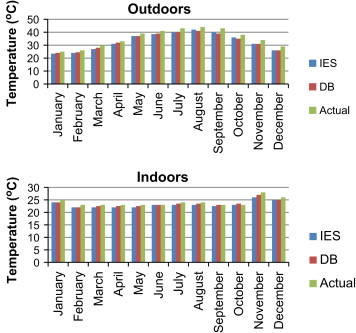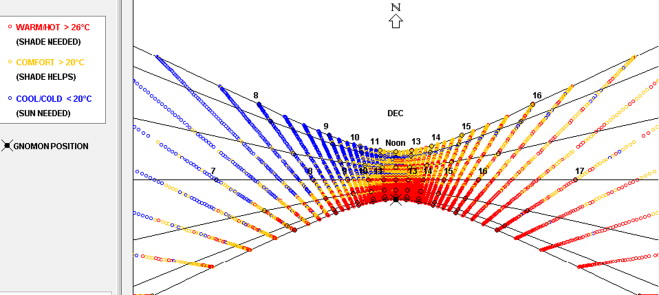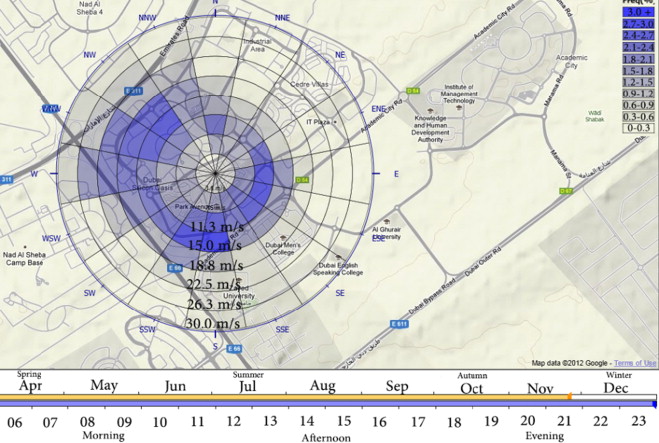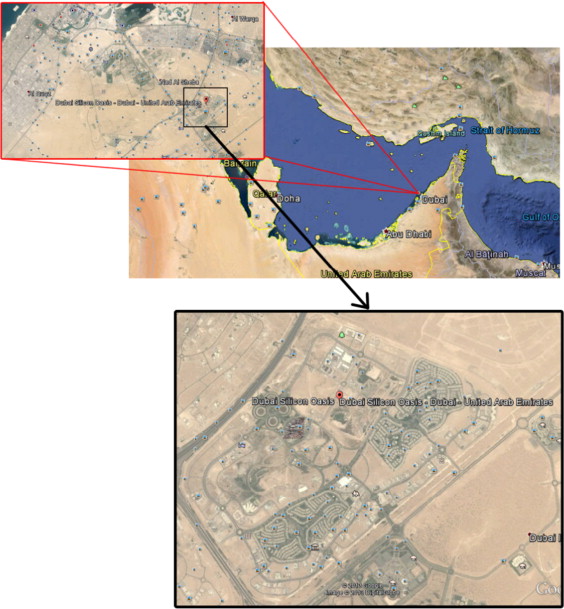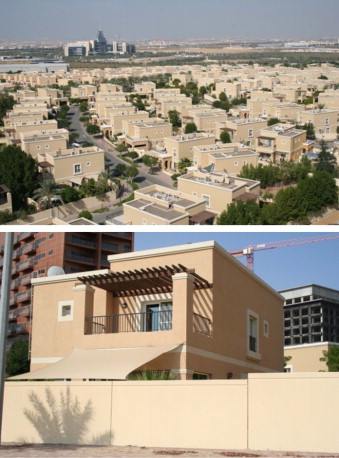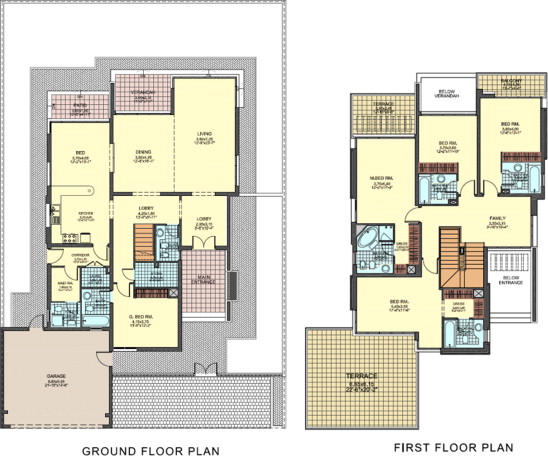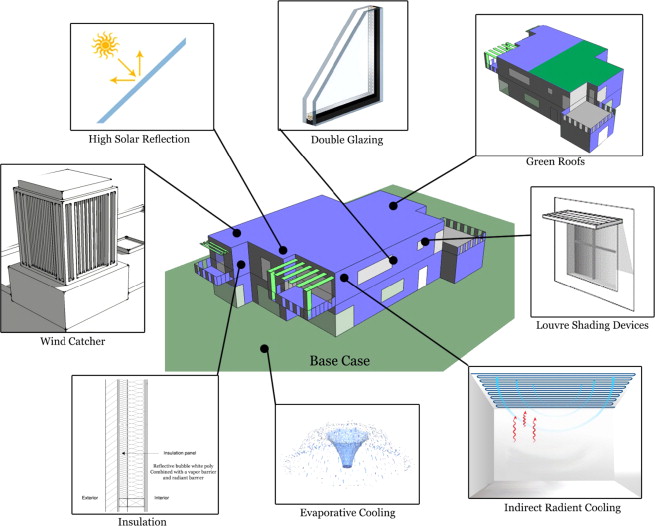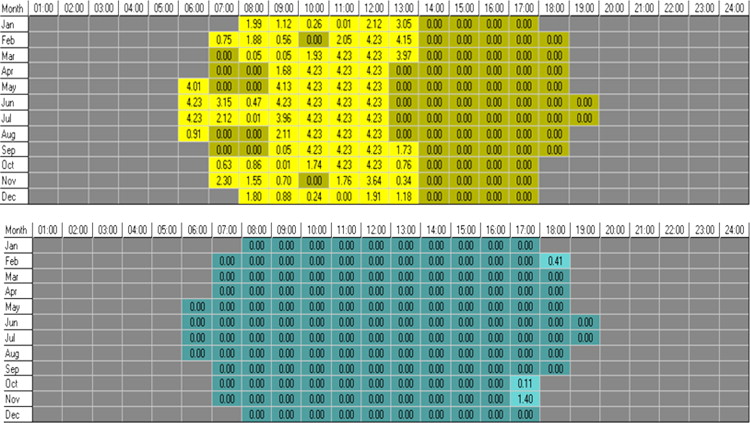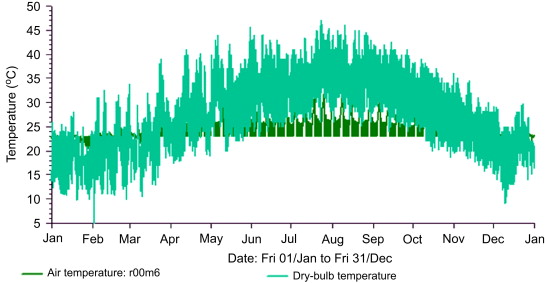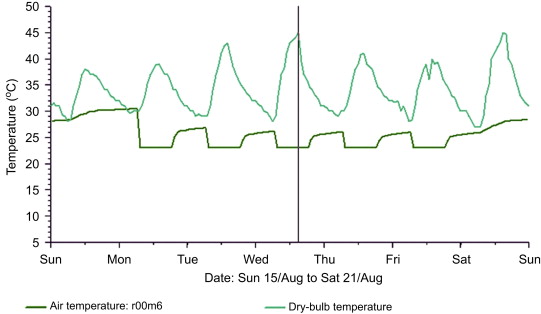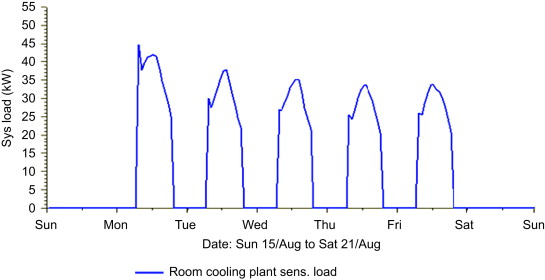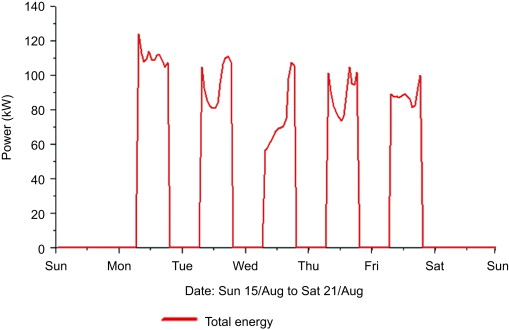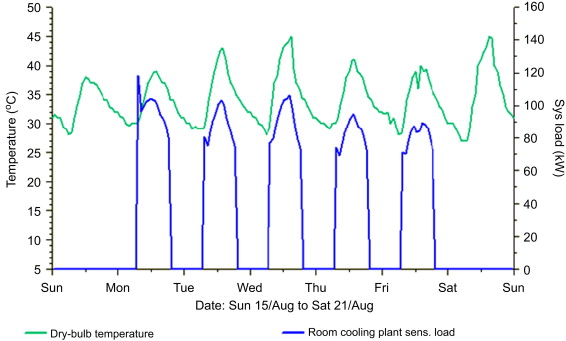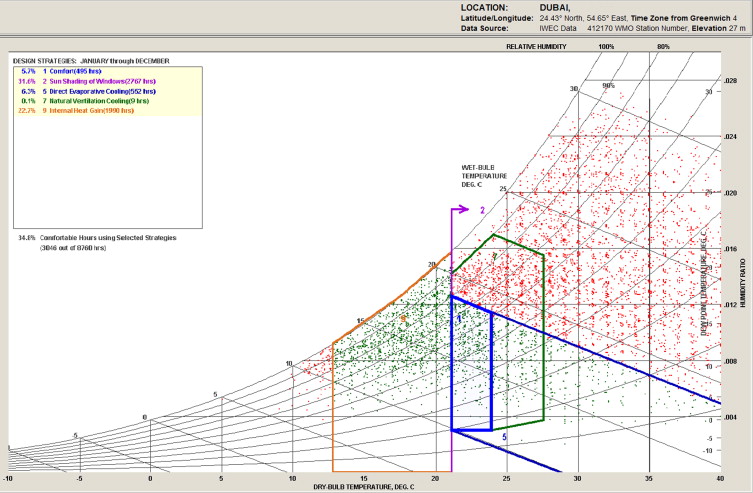Abstract
Passive design responds to local climate and site conditions in order to maximise the comfort and health of building users while minimising energy use. The key to designing a passive building is to take best advantage of the local climate. Passive cooling refers to any technologies or design features adopted to reduce the temperature of buildings without the need for power consumption. Consequently, the aim of this study is to test the usefulness of applying selected passive cooling strategies to improve thermal performance and to reduce energy consumption of residential buildings in hot arid climate settings, namely Dubai, United Arab Emirates. One case building was selected and eight passive cooling strategies were applied. Energy simulation software – namely IES – was used to assess the performance of the building. Solar shading performance was also assessed using Sun Cast Analysis, as a part of the IES software. Energy reduction was achieved due to both the harnessing of natural ventilation and the minimising of heat gain in line with applying good shading devices alongside the use of double glazing. Additionally, green roofing proved its potential by acting as an effective roof insulation. The study revealed several significant findings including that the total annual energy consumption of a residential building in Dubai may be reduced by up to 23.6% when a building uses passive cooling strategies.
Keywords
Passive cooling ; IES software ; UAE houses ; Evaporative cooling ; Shading devices
1. Introduction
1.1. Background
Passive cooling uses free, renewable sources of energy such as the sun and wind to provide cooling, ventilation and lighting needs for a household. This additionally removes the need to use mechanical cooling. Applying passive cooling means reducing differenecs between outdoor and indoor temperatures, improving indoor air quality and making the building both a better and more comfortable environment to live or work in. It can also reduce levels of energy use and environmental impacts such as greenhouse gas emissions. Interest in passive design for either heating or cooling has grown recently – particularly in the last decade – as a part of a movement towards sustainable architecture. Well-designed envelopes maximise cooling movement of air and exclude the sun in the summer season. There are many types of passive cooling strategies that can be recommended for use in a hot arid climate such as the United Arab Eirates (UAE). Design strategies that minimise the need for mechanical cooling systems include proper window placement and daylight design, the selection of suitable glazing for windows or skylights, proper sized shading of glass when heat gains are being avoided, the use of light or reflective-coloured materials for the building envelope and roof, careful siting and wise orientation decisions alongside appropriate landscaping design (Santamouris and Asimakopoulos, 1996 ).
1.2. Statement of the problem
Despite the massive potential for energy savings in buildings of UAE, the country has been identified as one of the highest carbon emitters per capita (WWF, 2012 ). Several factors have contributed to the existence of an inefficient building stuck in the country, including a construction boom; a lack of stringent green building practices and codes; artificially cheap prices of electricity and limited awareness with green building practices when compared with most of the advanced countries (Ghazal-Aswad et al., 2012 ).
1.3. Aim of the paper
The aim of this paper is to test the usefulness of applying selected passive cooling strategies to improve thermal performance and to reduce energy consumption of residential buildings in hot arid climate settings, namely, Dubai, United Arab Emirates. For the purpose of this investigation, a real case building was selected and eight passive cooling strategies were considered.
1.4. Research methodology
This study adopts ‘simulation study’ as the main investigatory method. Energy simulation software – namely IES (Integral Environmental Solution) – was used to assess the performance of the building. Solar shading performance was also assessed using Sun Cast Analysis, as a part of the IES software. Validation processes were attempted to calibrate the results including monitoring the temperature indoors and outdoors on different days of the year. Two simulation programs were also used for validation purposes – namely DesignBuilder and the IES. Against actual measuring on site, they recorded the highest temperatures in °C. The experimental process began in January 2011 and continued until December 2012 with averages being taken once each month during that period. Figure 1 shows that the difference between the three recorded temperatures came to less than 4.5%. Calibration took into account that air-conditioning was used during the summer, autumn and spring (with a set point of 22 °C), but was switched off during the winter – comprising November, December and January (Figure 2 ).
|
|
|
Figure 1. Calibration between the two software packages with the actual measurement on-site outdoors and indoors. |
|
|
|
Figure 2. Sun chart for Dubai (climate consultant software). |
According to Rahman et al. (2008) , if the difference recorded between measured and simulated readings is less than 5% then the modelling procedure can be described as valid. Thus, whilst the computed outdoor temperatures have validated the measurement experiment, the calibration of the indoor temperatures indicates a reasonable modelling accuracy when using the IES software. The next stage was to consider eight cooling strategies in order to assess the collective effect of applying all these strategies on shading, thermal performance and energy levels for the whole house. Thermal analysis was also conducted for the living room in particular. This zone was selected for this analysis because it occupies a large area with a reasonable glazed area, not to mention the fact that this is the zone that occupants spent most of their time in. The strategies considered for this study include evaporative cooling, improved shading and glazing arrangements, enhancing insulation, natural ventilation, radiant cooling and the application of light coloured coatings with high reflection in addition to green roofing. Whilst natural ventilation removes unwanted heat from the house, the remaining strategies were aimed to slow heat transfer into the villa, either by heat conduction or heat convection or thermal radiation that primarily comes from the sun.
1.5. Summary of findings and contributions
Energy reduction was achieved due to both the harnessing of natural ventilation and the minimising of heat gain in line with applying good shading devices alongside the use of double glazing. Additionally, green roofing proved its potential by acting as an effective roof insulation. The study revealed several significant findings including that the total annual energy consumption of a residential building in Dubai may be reduced by up to 23.6% when a building uses passive cooling strategies. The findings of this study will provide guidance to architects and planners on energy saving potentials of applying various passive cooling strategies in the UAE and places with similar climatic contexts. It is hoped, furthermore, that this paper will stimulate academic interest into this under-researched area of investigation.
1.6. Layout of the paper
Section 2 introduces the case of the UAE, its climate and the case building that has been selected for this research. Section 3 provides the literature review, which is comprised of two parts: (i) a review of previous research work and (ii) a description of the passive cooling strategies adopted in this paper. Section 4 details the results of the analysis, whilst Section 5 provides conclusions of this work.
2. The United Arab Emirates: a case study
2.1. Current status overview
The United Arab Emirates (UAE) is a fast growing nation with an active construction industry which is experiencing massive expansion. An especially important location is Dubai, which is considered to be one of the fastest growing cities in the world. A result of this continuing development is that these urban sprawls are constantly consuming more land and increasing energy demands. The government is therefore adopting policies and initiatives that both boost sustainable development and meet global energy demands. The use of glazed facades in modern architecture in the UAE has led to an increase in operational costs due to significantly higher solar gain.
An overview of the history of local architecture shows that passive cooling was generally used in the time before air-conditioning was invented. Among these strategies in the vernacular architecture was the Barjeel which features a wind tower. Nowadays, many international and local architectural firms as well as property developers, operating in the UAE, are implementing passive cooling strategies as a part of a movement towards a more ecological and sustainable approach. This can be seen in significant projects such as Masdar City in Abu Dhabi and Madinat Jumeirah in Dubai, where various concepts and techniques have been implemented to avoid an increased cooling load. Among the passive cooling techniques which are applicable in this hot, arid region are a considered use of natural ventilation, shading devices, responsive landscaping, thermal mass and the use of light-reflective colours ( Haggag and Elmasry, 2001 ).
2.2. Climate of Dubai
The climate across the UAE’s seven emirates is generally the same; therefore climate data from either Dubai or Abu Dhabi can be used as a representative of that of other emirates. The temperature range chart for Dubai shows that the UAE has a hot climate during most of the year, especially during the day. Night brings cooler temperatures, especially during the winter when the weather can border on the chilly. Summer in the UAE can be described as extending from May to October. Temperatures range from 28 °C to 36 °C reaching a maximum of 48 °C in the stifling months of July and August. Winter in the country extends from November to April of the following year, typically exhibiting mean temperatures that range from 17 °C to 27 °C. February normally sees the coolest temperatures, with lows reaching around 5 °C. The Sun Chart for Dubai shows that the south of the emirate requires shading devices to block solar gain while the north is considered to be a more comfortable zone due to a lack of direct solar radiation.
Wind in Dubai comes from different directions with a few variations in terms of wind velocity. Given that the north–west side experiences relatively higher wind velocities, it is considered to be the most attractive to exploit the wind. Figure 3 explains wind direction from different sides of the case study site.
|
|
|
Figure 3. Wind direction in Dubai (Ecotect Software). |
2.3. The selected case study
The location of the case study is the ‘Silicon Oasis Dubai’, a modern urban project that comprises residential villas and a flat complex as well as office buildings. There are several different types of villas, one of which was selected to act as a case study for this project. Figure 4 shows the location of this large scale project and its urban surroundings (Figure 5 ).
|
|
|
Figure 4. Case study location in Dubai. Source : Google Earth. |
|
|
|
Figure 5. Photographs of the selected case study villa and its surrounding context. Source : Author. |
This second phase of the development entails 560 villas of some 944.88 m2 each. Figure 6 shows floor plans of the one villa unit which acted as a case study for this research paper. The main orientation of the villa is towards the south and it is occupied by five tenants, including a maid.
|
|
|
Figure 6. Floor plan of the case study villa. |
3. Theoretical background
3.1. A review of previous research work
The IES software, which has been used in this paper, is a reputable simulation tool that has been used in various academic studies (e.g. El-Sherif, 2012 ; Liotsios, 2012 ; Sadrzadehrafiei et al ., 2011 ). Considering studies that have compared different passive cooling techniques, it seems that evaporative cooling is an effective with regard to reducing incoming heat flux through the roof if water is readily available. The use of the air cavity will greatly reduce the incoming flux entering through walls (Tiwari et al., 1994 ). A review of the literature reveals the existence of a limited number of studies that have examined passive means in the buildings of UAE. For example, roof solar chimney coupled with wind cooled cavity was proved to reduce the energy consumption in this hot arid region (Aboulnaga, 1998 ). A recent study indicated that the use of green roofing in the city of Abu Dhabi – the capital city of the UAE – has acted as a buffer, protecting the building from extreme solar radiation and therefore reducing net heat gain. Consequently, this has helped in cooling the surrounding area as well as regulating the internal building temperature and decreasing the amount of energy required to cool the building structure. It was suggested that a green roof could also reduce the requirements for traditional insulation (Al-Sallal et al., 2013 ). Another study conducted, conducted by Al-Sallal and Al-Rais (2012) , has investigated passive cooling performance in modern urban contexts of Dubai. Three cases were simulated with laminar and turbulent wind flow as a passive cooling via natural ventilation and its impact on human comfort depending on the ASHRAE adaptive model.
In a different part of the world, Gong et al. (2012) adopted an approach in which the orthogonal and listing methods are integrated to explore how energy consumption is minimised in residential buildings by optimising seven passive design measures for different Chinese cities. These measures included the altering thickness of the walls, thickness of roof insulation, thickness of external wall insulation, window orientation, window–wall ratio, glazing type and sunroom depth/overhang depth. Through optimisation, the study has proved that passive design could considerably reduce thermal load of buildings.
3.2. Passive cooling strategies
Eight principal passive cooling strategies were applied to the case study villa (as shown in Figure 7 ), and there follows a brief description of each strategy and a justification for its use.
|
|
|
Figure 7. Schematic of the adopted passive cooling design strategies. |
3.2.1. Louver shading devices
A louvered shading device was positioned in the south east façade of the building in order to block sun gain in summer and to also allow wind to pass through it and cool the area. The shading is designed in such a way that it blocks the sun in summer yet allows it to enter in the winter. The louvers were horizontally placed and rotated to 45 (tilt angle) degrees. When sun is high, the louvers will ignore the heat and still allow the light needed for the area. Louvered shading devices were therefore applied to the south east elevation.
3.2.2. Double glazing
Recent studies indicate that in order to reduce energy and achieve thermal comfort in a building, there are parameters that should be considered such as humidity, noise, lighting and temperature (Noh-Pat et al., 2001 ). In buildings most of the heat gain or losses comes from openings such as windows. It is clear, therefore, that windows are the main element in the transfer of huge amounts of heat between a building and the exterior environment. The insulation of a window is determined by the space between two glass panels. The cavity created between the two panes of glasses can either be filled by gas or vacuumed. In this design, the glass is filled with argon in order to reduce the transmission of heat. All the glass uses solar control film to decrease energy by 55% compared to DGV without any solar control. The SHGC (solar heat gain coefficient) is about 17%, which can be interpreted as a good value and is also considered to be a low CO2 committer. To this end, the single glazing in the case study villa was replaced by double glazing with a 16 mm cavity containing Argon instead of air.
3.2.3. Natural ventilation: wind catcher and cross ventilation
Hughes explains that wind catchers are old designs which were used in the past to introduce cool air into a building (Hughes et al., 2012 ). Natural ventilation is an efficient way to reduce energy consumption as well as providing a healthy indoor environment. Wind towers provide a low carbon ventilation system which can deliver fresh air to the occupants without using any kind of mechanical system. It can further be assumed that the air is both clean and fresh because of the reduction of pollution in the airflow rate. Differences in air temperature and pressure direct the air into the building. It is clear that temperature differences, velocity and the direction of wind can be considered as being the main elements surrounding natural ventilation. It is therefore important that the wind tower is located in the correct position. The study showed clearly that exterior windows have an important role to play in ventilation. They can also help to move hot air out, so a buoyancy effect can be created by the use of exterior openings. In this building, air moves through the rooms, halls and staircases rather than using ducts for airflow.
To avoid turbulence from the rooftop, the height of the wind catcher must be carefully calculated. A taller wind catcher may provide negative pressure and produce better ventilation and fresh air. In this design, the required height of the wind catcher is assumed as being about 10 m, which is a typical height in the region. The louvered opening is pointed towards the most effective windward direction, which is mostly the north–west in the case of Dubai; this is to obtain the most positive pressure. In the case study, a wind catcher was proposed and installed with partitions fitted in order to help direct airflow to the building and increase air pressure.
In addition to the suggested wind catcher, enhancements to natural ventilation have been recommended, especially with regard to cross ventilation. Cross ventilation has several advantages; it removes hot air and brings fresh air to the building while also lowering the temperature so that the loading energy will be reduced. It has the effect of providing healthier air to occupants and ensuring that the building ventilation is providing natural, fresh air from outside to inside the building while pulling the exhaust air outside. The levels of pollution or dust which come from mechanical systems will also be reduced. In the case study, cross ventilation was encouraged by opening the terraces and windows.
3.2.4. Green roofing
A review of the literature indicates that a green roof can be defined as a ‘building roof covered by grasses or plants which lie over a waterproof membrane’ (Jaffal et al., 2012 ). It is regarded as the best method of insulation for a roof. Studies show that the roof is one of the main solar heat gain points in a building, so by using a high level of insulation it can reduce heat conduction to the interior of the building. The other important sustainable points are producing oxygen for the environment, reducing the heat island effect in the urban environment and reducing air temperature. There are two kinds of green roof, which can be categorised as either intensive or extensive. An intensive green roof requires more maintenance than an extensive one; it is also thicker and requires a variety of plants. An extensive living roof also requires less maintenance. For this kind of eco-roof a variety of light plants are chosen to create a light layer of roof.
A green roof is composed of different layers consisting of drainage and barriers for roots plus channels for water. The spaces below the panels allow the air to move and create heat in their roots, thereby providing better ventilation below the membrane panels locked together to create a platform and stay stable. It will also include some drainage for water runoff. The material used for this kind of retention is recycled plastic and the size is ASTM standard. These panels are soft enough to be cut easily and fitted to the surrounding area. It is anticipated that an eco-roof can decrease the temperature of the roof slab by 30 °C as well as reducing energy demand by 6% (Jaffal et al., 2012 ). In the case study villa, the area used for the green roof is about 220 m2 and sprinklers have been installed to facilitate evaporative cooling on the roof. This ensures that the roof temperature stays cool even in a hot summer.
3.2.5. Insulation
Passive design must include insulation to reduce heat loss or gain throughout the building envelope. Insulation acts as a barrier to heat flow, reducing heat loss in winter to keep the house warm and reducing heat gain in summer to keep the house cool. Inadequate insulation and air leakage are the main causes of heat loss in buildings. Insulation is therefore used in walls, ceiling and floors. For this case study, reflective bubble white poly insulation was used with an R -value of 15.67 m2 K/W combined with a class 1 vapour barrier and radiant barrier.
3.2.6. Evaporative cooling via fountain
A fountain can cool the air when it combines with water and evaporates leading to a reduction in air temperature. In order to obtain the best effect from cooling by this method, the interaction between water and air needs to be as widespread as possible. If water is distributed well, this will be more effective in cooling the air. It should also be noted that the water does not simply cool the air, it also cleans it.
Water can remove dust or other contaminants which are found in air; these both refresh the air and create a fresher and more pleasant environment. A recent study has investigated novel designs and provided modelling for an evaporative cooling system suitable for buildings in hot arid regions (Qui and Riffat, 2006 ). That study pointed out that a typical example illustrates that approximately 20 kg of water is evaporated and around 26 min are required for 980 kg of water to be cooled from 28 °C to the wet bulb temperature of 19.2 °C of ambient air in a typical arid hot climate. For this study two fountains were utilised, one placed in the front and another in the back yard of the villa.
3.2.7. Indirect radiant cooling
In a further attempt to cool the temperature of the roof, the radiant cooling method was utilised. Radiant cooling takes place through the net emission of electromagnetic waves from warm objects to cool ones. The process then continues until both objects reach the same temperature. The setup proposed for this case study is known as nocturnal cooling, which is only applicable to the second storey of the villa due to its proximity to the roof area. It involves radiant cooling of a specialised radiator that is made of a metallic plate with an air space above it (as shown in Figure 7 ). The air cooled by the long-wave radiation under the metallic radiator is used to cool the indoor space of the second storey (Watson and Chapman, 2002 ).
3.2.8. Light colour coatings with high reflection
According to Shen et al. (2001) , exterior walls exposed to solar radiation can transfer a huge amount of heat to a building; this therefore affects the temperature of interior spaces and can also decrease the comfort level temperature. To reduce heat transmission, solar reflective coating can be used to reduce the temperature of the interior in addition to the cooling loads. The studies show that temperatures were reduced by 4 °C when it is used alongside painting in grey or darker colours. Cooler colours will additionally produce more infrared radiation than others. The coating of the light colours is dependent on both the climate and the type of material that is used. Considering these parameters can lead to energy being saved, especially at peak times.
Three different types of coating were used in this paper to measure the effect of each colour on energy consumption. The first type was a normal coating, whereas the second and third had a higher reflection rate. These different kinds of coatings were used on three different walls to estimate the surface and indoor temperature plus its effect on energy performance. The reflection levels for each coating were 32%, 42% and 61%. From this piece of research therefore, it can be understood that coating the building with highly reflective coatings can reduce the heat which transfers through the exterior walls to the interior. This has an effect on the building temperature and introduces increased comfort levels to the occupants. Using a paint with a 61% reflection of the spectrum can have a beneficial effect on energy saving. A layer with a very high reflectivity consisting of pigment, butyl acetate and ethylene was used as coating. Type C was chosen for the building with regard to its high level of reflectivity.
4. Building performance and analysis
In a hot and arid region, mechanical systems are frequently used to cool the environment to make it more comfortable for users. The effect of this is that the energy load is increasing and consequently the need for electricity is rising. Passive design strategies can reduce the load of active systems if they are applied correctly. Through the use of the IES simulation software, the effect of passive strategies on shading, thermal performance and energy levels was analysed.
4.1. Solar shading performance using sun cast analysis
Analysis of the north façade shows that a wall of 35 m2 is shaded all year, apart from May to August in the morning when the sun is higher and in the evening from 3 to 7 pm (external wall), where the internal surface obtains the maximum solar radiation level of 0.58 m2 . Analysis of the west façade shows that a wall of 30 m2 is shaded all year, except for mornings until 12 noon (external wall), whereas the internal surface gets the maximum solar radiation level of 3.45 m2 .
As shown in Figure 8 , analysis shows that the south–east wall is shaded all year except for mornings until 12 noon (external wall) and that the maximum is estimated to be 4.23 m2 , the internal surface receives a maximum solar radiation level of 1.4 m2 .
|
|
|
Figure 8. South–east façade wall. |
4.2. Thermal analysis
Thermal analysis was done for the building utilising passive cooling strategies. The simulation was done for one week – from 15th to 21st of August – which is considered to be the hottest week of the year. Figure 9 shows the temperatures both outside and inside of the living room that was selected for analysis for the whole year, whilst Figure 10 shows the temperature during the hottest week of the year. As mentioned earlier, the living room was selected for this thermal analysis because it occupies a large area with a reasonable glazed area, not to mention the fact that this is zone that occupants spent most of their time in.
|
|
|
Figure 9. Temperatures outside and inside of the selected zone. |
|
|
|
Figure 10. Air and dry bulb temperature outside and inside of the selected zone during the hottest week of the year. |
It can be observed from Figure 10 that the temperature peaks from June to September at around 45 °C. After applying passive cooling strategies, the temperature inside the living room, which has an area of 35 m2 and is located in the north west of the property decreased from about 23 to 25 °C. The results show the room temperature to be about 20 °C which can be described as being in a comfortable zone. It can also be inferred that the shading has had a significant effect on the reduction of temperature.
4.3. Cooling sensible loads
The term ‘design cooling load’ refers to the amount of heat energy removed from a house by any cooling means to maintain the house at the indoor design temperature when the worst case outdoor design temperature is being experienced. The term ‘sensible cooling load’ refers to the dry bulb temperature of the building. A simulation was done to consider the cooling load of the villa. Figure 11 illustrates that the maximum cooling load – which was evaluated over the hottest week – reached approximately 43 kW.
|
|
|
Figure 11. Cooling loads performed during the hottest week. |
4.4. Total energy consumption
Given the energy consumption of the building (represented by the area under the curve in Figure 12 ), the peak power reached 120 kW whilst the minimum power was just 60 kW.
|
|
|
Figure 12. Total energy consumption in the building during the hottest week. |
It is worth mentioning here that these results look impressive when compared to the actual utility bills, but the tenants admit that their consumption is higher than the specified numbers. However, this result shows energy reduction due to the application of many passive cooling strategies that have not yet happened in real life. It gives a representation of future results should these passive cooling strategies be adopted. Significantly, comparing the simulation results with real bills, it can be envisaged that these passive cooling strategies might help tenants to reduce their annual energy consumption by up to 23.6%. Figure 13 shows that the load is decreased by 9% which shows that passive cooling strategies can also help the building to reduce energy consumption.
|
|
|
Figure 13. Cooling load in the case study villa. |
It is worth mentioning that an effort was also made to compare the temperature results to a psychometric chart. The aim was to confirm that all the temperatures achieved from using passive cooling strategies were within the comfort zone for Dubai (see Figure 14 ). It was concluded that the results gained from this simulation are within the human comfort zone.
|
|
|
Figure 14. Passive design strategies for Dubai’s climate (climate consultant software). |
5. Conclusions
In a passive cooling design, it is important that all main elements of the building should either block or reject solar heat gain and try to keep the building cool against the heat of summer. Passive design depends on the climatic conditions of the area and should therefore be designed accordingly. A passive building is often the key foundational element of a cost-effective zero energy building. In a hot and arid climate, most of the energy load is from mechanical systems, so this load could be reduced by adding elements to the building, such as louvered shading devices which can significantly reduce energy consumption. This paper shows that shading devices can block solar heat and could also provide lighting. The provision of proper openings in the building means that fresh air can be distributed equally all over. This paper further investigated potential passive cooling strategies for Dubai, a real case study was selected and eight suggested passive cooling strategies were applied. IES software was the main simulation tool. The simulation results were analysed and proved the potential for energy reduction and the achievement of optimal thermal comfort if passive cooling strategies were used. All the achieved temperatures from using passive cooling strategies were within the comfort zone for Dubai. In-depth analysis shows that there is a potential for reduction of the cooling load by 9% after applying these passive cooling strategies. Total annual energy consumption could also be reduced by 23.6% in a situation where the building used passive cooling strategies.
Acknowledgements
The author would like to thank the anonymous reviewers for their constructive comments and informed suggestions for improving an earlier version of this paper.
References
- Aboulnaga, 1998 M.M. Aboulnaga; A roof solar chimney assisted by cooling cavity for natural ventilation in buildings in hot arid climates: an energy conservation approach in Al-Ain city; Renew. Energy, 4 (1998), pp. 357–363
- Al-Sallal and Al-Rais, 2012 K. Al-Sallal, L. Al-Rais; Outdoor airflow analysis and potential for passive cooling in the modern urban context of Dubai; Renew. Energy, 38 (2012), pp. 40–49
- Al-Sallal et al., 2013 K. Al-Sallal, L. Al-Rais, M.B. Dalmouk; Designing a sustainable house in the desert of Abu Dhabi; Renew. Energy, 49 (2013), pp. 80–84
- El-Sherif, 2012 El-Sherif, S.K., 2012. The Impact of Overhangs and Side-fins on Building Thermal Comfort, Visual Comfort and Energy Consumption in the Tropics (MSc thesis), British University in Dubai.
- Ghazal-Aswad et al., 2012 N. Ghazal-Aswad, Y.M. Al-Saleh, H. Taleb; Clean energy awareness campaigns in the UAE: an awareness promoters perspective; Int. J. Innovation Knowl. Manag. MENA, 2 (2012), pp. 131–156
- Gong et al., 2012 X. Gong, Y. Akashi, D. Sumiyoshi; Optimization of passive design measures for residential buildings in different Chinese areas; Build. Environ., 58 (2012), pp. 46–57
- Haggag and Elmasry, 2001 M.A. Haggag, S.K. Elmasry; Integrating passive cooling techniques for sustainable building performance in hot climate with reference to the UAE; C.A. Brebbia, E. Beriatos (Eds.), Sustainable Development and Planning, WIT Press, Southampton (2001), pp. 201–212
- Hughes et al., 2012 B.R. Hughes, J.K. Calautit, S.A. Ghani; The development of commercial wind towers for natural ventilation: a review; Appl. Energy, 92 (2012), pp. 606–627
- Jaffal et al., 2012 I. Jaffal, S.E. Ouldboukhitine, R. Belabi; A comprehensive study of the impact of green roofs on building energy performance; Renew. Energy, 43 (2012), pp. 157–164
- Liotsios, 2012 Liotsios, K., 2012. 3D Modeling and Energy Simulation of a Single Family House in Southern Greece (MSc thesis), KTH School of Architecture and the Built Environment.
- Noh-Pat et al., 2001 F. Noh-Pat, J. Xaman, G. Alvarez, Y. Chaves, J. Arce; Thermal analysis for a double glazing unit with and without a solar control film (SnS–Cux S) for using in hot climates ; Energy Build., 43 (2001), pp. 704–712
- Qui and Riffat, 2006 G.Q. Qui, S.B. Riffat; Novel design and modeling of an evaporative cooling system for buildings; Int. J. Energy Res., 30 (2006), pp. 985–999
- Rahman et al., 2008 Rahman, M.M., Rasul, M.G. Khan, M.M.K., 2008. Energy conservation measures in an institutional building by dynamic simulation using DesignBuilder. In: Third International Conference on Energy and Environment, Cambridge, 23–25 February.
- Sadrzadehrafiei et al., 2011 S. Sadrzadehrafiei, K Sopian, S. Mat, C.H. Lim; Determining the cost saving and emission reduction of optimum insulation thickness and air gap for building wall; Aust. J. Basic Appl. Sci., 5 (2011), pp. 2287–2304
- Santamouris and Asimakopoulos, 1996 M. Santamouris, D. Asimakopoulos; Passive Cooling of Buildings; James & James Science Publisher Limited, London (1996)
- Shen et al., 2001 H. Shen, H. Tan, A. Tzempelikos; The effect of reflective coatings on building surface temperature, indoor environment and energy consumption; Energy Build., 43 (2001), pp. 573–580
- Tiwari et al., 1994 G.N. Tiwari, M. Upadhyay, S.A. Rai; Comparison of passive cooling techniques; Build. Environ., 29 (1994), pp. 21–31
- Watson and Chapman, 2002 R.D. Watson, K.S. Chapman; Radiant Heating and Cooling Handbook; McGraw-Hill, London (2002)
- WWF, 2012 WWF, 2012. ‘Living Planet Report 2012: World Wildlife Fund’. Available at 〈http://wwf.panda.org/about_our_earth/all_publications/living_planet_report/〉 (accessed 7.12.13).
Document information
Published on 12/05/17
Submitted on 12/05/17
Licence: Other
Share this document
Keywords
claim authorship
Are you one of the authors of this document?
